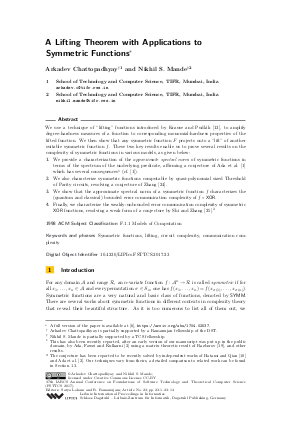A Lifting Theorem with Applications to Symmetric Functions
Authors Arkadev Chattopadhyay, Nikhil S. Mande
-
Part of:
Volume:
37th IARCS Annual Conference on Foundations of Software Technology and Theoretical Computer Science (FSTTCS 2017)
Part of: Series: Leibniz International Proceedings in Informatics (LIPIcs)
Part of: Conference: IARCS Annual Conference on Foundations of Software Technology and Theoretical Computer Science (FSTTCS) - License:
 Creative Commons Attribution 3.0 Unported license
Creative Commons Attribution 3.0 Unported license
- Publication Date: 2018-02-12
File

PDF
LIPIcs.FSTTCS.2017.23.pdf
- Filesize: 0.53 MB
- 14 pages
Document Identifiers
Subject Classification
Keywords
- Symmetric functions
- lifting
- circuit complexity
- communication com- plexity
Metrics
- Access Statistics
-
Total Accesses (updated on a weekly basis)
0PDF Downloads0Metadata Views
Abstract
We use a technique of “lifting” functions introduced by Krause and Pudlak [Theor. Comput. Sci., 1997], to amplify degree-hardness measures of a function to corresponding monomial-hardness properties of the lifted function. We then show that any symmetric function F projects onto a “lift” of another suitable symmetric function f . These two key results enable us to prove several results on the complexity of symmetric functions in various models, as given below: 1. We provide a characterization of the approximate spectral norm of symmetric functions in terms of the spectrum of the underlying predicate, affirming a conjecture of Ada et al. [APPROX-RANDOM, 2012] which has several consequences. 2. We characterize symmetric functions computable by quasi-polynomial sized Threshold of Parity circuits. 3. We show that the approximate spectral norm of a symmetric function f characterizes the (quantum and classical) bounded error communication complexity of f o XOR. 4. Finally, we characterize the weakly-unbounded error communication complexity of symmetric XOR functions, resolving a weak form of a conjecture by Shi and Zhang [Quantum Information & Computation, 2009]
Cite As Get BibTex
Arkadev Chattopadhyay and Nikhil S. Mande. A Lifting Theorem with Applications to Symmetric Functions. In 37th IARCS Annual Conference on Foundations of Software Technology and Theoretical Computer Science (FSTTCS 2017). Leibniz International Proceedings in Informatics (LIPIcs), Volume 93, pp. 23:1-23:14, Schloss Dagstuhl – Leibniz-Zentrum für Informatik (2018)
https://doi.org/10.4230/LIPIcs.FSTTCS.2017.23
BibTex
@InProceedings{chattopadhyay_et_al:LIPIcs.FSTTCS.2017.23,
author = {Chattopadhyay, Arkadev and Mande, Nikhil S.},
title = {{A Lifting Theorem with Applications to Symmetric Functions}},
booktitle = {37th IARCS Annual Conference on Foundations of Software Technology and Theoretical Computer Science (FSTTCS 2017)},
pages = {23:1--23:14},
series = {Leibniz International Proceedings in Informatics (LIPIcs)},
ISBN = {978-3-95977-055-2},
ISSN = {1868-8969},
year = {2018},
volume = {93},
editor = {Lokam, Satya and Ramanujam, R.},
publisher = {Schloss Dagstuhl -- Leibniz-Zentrum f{\"u}r Informatik},
address = {Dagstuhl, Germany},
URL = {https://drops.dagstuhl.de/entities/document/10.4230/LIPIcs.FSTTCS.2017.23},
URN = {urn:nbn:de:0030-drops-83839},
doi = {10.4230/LIPIcs.FSTTCS.2017.23},
annote = {Keywords: Symmetric functions, lifting, circuit complexity, communication com- plexity}
}
Author Details
References
-
Anil Ada, Omar Fawzi, and Hamed Hatami. Spectral norm of symmetric functions. In Approximation, Randomization, and Combinatorial Optimization. Algorithms and Techniques - 15th International Workshop, APPROX 2012, and 16th International Workshop, RANDOM 2012, Cambridge, MA, USA, August 15-17, 2012. Proceedings, pages 338-349, 2012.

-
Anil Ada, Omar Fawzi, and Raghav Kulkarni. On the spectral properties of symmetric functions. Arxiv, 2017.

-
László Babai, Peter Frankl, and Janos Simon. Complexity classes in communication complexity theory (preliminary version). In 27th Annual Symposium on Foundations of Computer Science, Toronto, Canada, 27-29 October 1986, pages 337-347, 1986.

-
Jehoshua Bruck and Roman Smolensky. Polynomial threshold functions, AC^0 functions, and spectral norms. SIAM J. Comput., 21(1):33-42, 1992.

-
Jin-yi Cai, Frederic Green, and Thomas Thierauf. On the correlation of symmetric functions. Mathematical Systems Theory, 29(3):245-258, 1996.

- Arkadev Chattopadhyay and Nikhil S. Mande. Dual polynomials and communication complexity of XOR functions. CoRR, abs/1704.02537, 2017. URL: http://arxiv.org/abs/1704.02537.
-
Mikael Goldmann, Johan Håstad, and Alexander A. Razborov. Majority gates VS. general weighted threshold gates. Computational Complexity, 2:277-300, 1992.

-
Mika Göös, Toniann Pitassi, and Thomas Watson. Deterministic communication vs. partition number. In IEEE 56th Annual Symposium on Foundations of Computer Science, FOCS 2015, Berkeley, CA, USA, 17-20 October, 2015, pages 1077-1088, 2015.

-
Mika Göös, Toniann Pitassi, and Thomas Watson. Query-to-communication lifting for BPP. CoRR, abs/1703.07666, 2017.

-
Hamed Hatami and Yingjie Qian. The unbounded-error communication complexity of symmetric xor functions. Arxiv, 2017.

-
Hartmut Klauck. Lower bounds for quantum communication complexity. SIAM J. Comput., 37(1):20-46, 2007.

-
Matthias Krause. On the computational power of boolean decision lists. Computational Complexity, 14(4):362-375, 2006.

-
Matthias Krause and Pavel Pudlák. On the computational power of depth-2 circuits with threshold and modulo gates. Theor. Comput. Sci., 174(1-2):137-156, 1997.

-
Troy Lee and Adi Shraibman. Lower bounds in communication complexity. Foundations and Trends in Theoretical Computer Science, 3(4):263-398, 2009.

-
Marvin Minsky and Seymour Papert. Perceptrons - an introduction to computational geometry. MIT Press, 1987.

-
Noam Nisan and Mario Szegedy. On the degree of boolean functions as real polynomials. Computational Complexity, 4:301-313, 1994.

-
Ramamohan Paturi. On the degree of polynomials that approximate symmetric boolean functions (preliminary version). In Proceedings of the 24th Annual ACM Symposium on Theory of Computing, May 4-6, 1992, Victoria, British Columbia, Canada, pages 468-474, 1992.

-
Ran Raz and Pierre McKenzie. Separation of the monotone NC hierarchy. Combinatorica, 19(3):403-435, 1999.

-
Alexander A. Razborov. Quantum communication complexity of symmetric predicates. Izvestiya: Mathematics, 67(1):145, 2003.

-
Alexander A. Sherstov. The unbounded-error communication complexity of symmetric functions. Combinatorica, 31(5):583-614, 2011.

-
Mario Szegedy. Functions with bounded symmetric communication complexity, programs over commutative monoids, and ACC. J. Comput. Syst. Sci., 47(3):405-423, 1993.

-
Andrew Chi-Chih Yao. Some complexity questions related to distributive computing (preliminary report). In Proceedings of the 11h Annual ACM Symposium on Theory of Computing, April 30 - May 2, 1979, Atlanta, Georgia, USA, pages 209-213, 1979.

-
Shengyu Zhang. Efficient quantum protocols for XOR functions. In Proceedings of the Twenty-Fifth Annual ACM-SIAM Symposium on Discrete Algorithms, SODA 2014, Portland, Oregon, USA, January 5-7, 2014, pages 1878-1885, 2014.

-
Zhi-Li Zhang. Complexity of symmetric functions in perceptron-like models. Master’s thesis, University of Massachusetts at Amherst, 1992.

-
Zhiqiang Zhang and Yaoyun Shi. Communication complexities of symmetric XOR functions. Quantum Information & Computation, 9(3):255-263, 2009.

